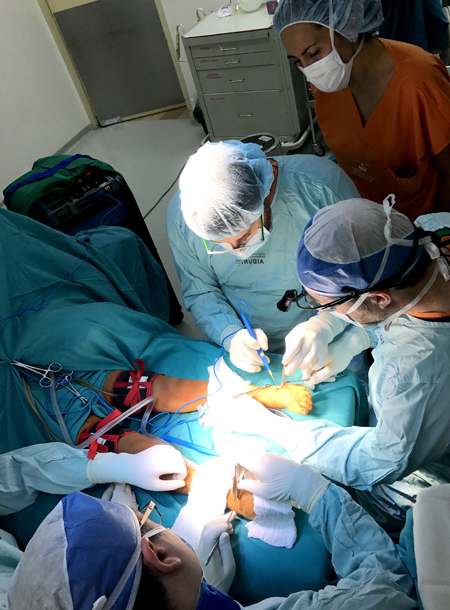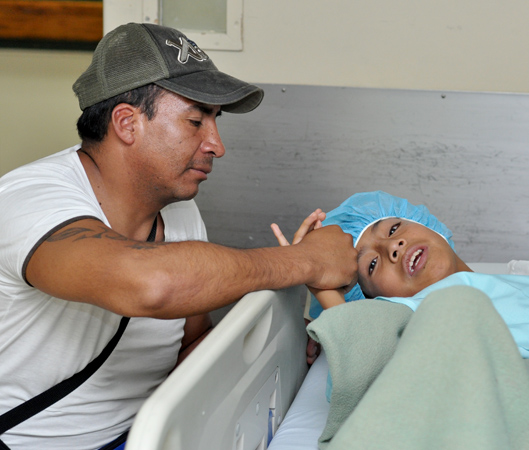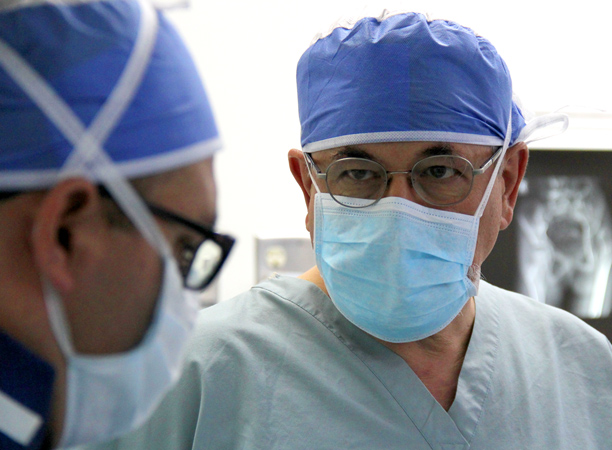MENU
(April 19, 2017 - by Ralph Kurtenbach) Converging on Quito, Ecuador, orthopedic surgeons recently traveled from four countries with the aim of correcting that which is mal (wrong or bad) in their pediatric patients and making it right.
 “The work was to help children who have malalignments of their legs to function better and to help preserve their joints,” explained Dr. Tom Novacheck of Gillette Children’s Specialty Healthcare in St. Paul, Minn. “So many of these children have developmental problems—maybe neurological, maybe muscular—that affect the way their feet develop, and [their] hips and knees.”
“The work was to help children who have malalignments of their legs to function better and to help preserve their joints,” explained Dr. Tom Novacheck of Gillette Children’s Specialty Healthcare in St. Paul, Minn. “So many of these children have developmental problems—maybe neurological, maybe muscular—that affect the way their feet develop, and [their] hips and knees.”
Former Reach Beyond missionary Dr. Eckehart Wolff coordinated the two-week outreach (Feb. 23-March 3) with operations performed on 23 patients ranging in age from 3 to 23.
Orthopedic surgeons on their feet for long hours in an operating room at the mission’s Hospital Vozandes-Quito means one thing to those whose walking is impaired or impossible: feet and legs that can support and carry them.
Their approach of using two surgical teams—a team working on each side of the patient—allows for simultaneous correction of mobility problems that are often a consequence of cerebral palsy (CP). The multiple operations approach is what Dr. Jim Gage has called “one of the things that differentiates our approach from conventional CP surgery.”
 Gage was medical director at the hospital in St. Paul when in 1995 he met Dr. Wally Swanson, who asked him to be a volunteer surgeon at Reach Beyond’s former Hospital Vozandes-Shell, also known as Hospital Vozandes del Oriente.
Gage was medical director at the hospital in St. Paul when in 1995 he met Dr. Wally Swanson, who asked him to be a volunteer surgeon at Reach Beyond’s former Hospital Vozandes-Shell, also known as Hospital Vozandes del Oriente.
The program of helping Ecuadorians to walk began with one child. Gage was asked, “Can this boy be helped?” as he studied before him a 12-year-old whose mobility consisted of crawling. Struck by a car a decade earlier, the boy had been left crippled.
“Not here [in Shell]; his problem is too complex,” Gage responded. And yet after multiple operations, the boy, Ivan Sisa, is able to not only walk (aided by crutches) but went on to become a physician in his own right.
Helping one boy sparked an annual event where orthopedic surgeons travel to Quito from the Americas to give Latinos (mostly Ecuadorian children) a hand at getting on their feet. A hospital franchise in Chile, Instituto Teletón (a la Jerry Lewis Muscular Dystrophy telethons), sends physicians annually.
“It’s really not possible for people from here to go to the U.S. for medical care,” said Novacheck, adding that the children’s families don’t face crushing financial burdens after the surgeries are done. “We pay our own expenses, so that is part of our mission.”
 Wolff, who operates a family practice clinic in the former Shell hospital along with Ecuadorian surgeon Dr. Geovanny Oleas and a couple of young orthopedic surgeons, keeps in regular contact with families of the patients.
Wolff, who operates a family practice clinic in the former Shell hospital along with Ecuadorian surgeon Dr. Geovanny Oleas and a couple of young orthopedic surgeons, keeps in regular contact with families of the patients.
“Many times these malalignments are at multiple levels,” explained Novacheck. “It’s not just a single foot problem for a patient—it could be their hip and their knee and their foot (or ankle)—all together. So packaging those surgeries together is difficult and complicated work, and Dr. Wolff sees these patients through the course of the year.” It’s during follow-up that conversations about Christ happen with the patients’ families, according to Wolff.
On one particular day in surgery, Drs. Ana Paula Tedesco (Brazil) and Steven Koop (U.S.) work steadily at the right hip while Drs. Leonardo Abrahão and Lucas de Oliviera (Brazil) focus on the left hip of the patient, a teenage girl. Periodically, Abrahão calls out, “Rayo,” requesting an updated view of their work as shown on HVQ’s C-arm fluoroscopy (a moving x-ray image).
Other equipment is lower tech—a wisp of vapor rises perhaps from cauterizing a blood vessel within the incision; a tape measure (“Measure twice; cut once,” quips Koop in a conversation later that day) and even the tap, tap, tap of a hammer.
In the skillful hands of these volunteers are the tools that might sound like a workshop—a workshop where the gift to a child is mobility.
This year’s participants included Drs. Ana Paula Tedesco, Leonardo Abrahão and Lucas de Oliviera from Brazil; Drs. Ana Maria Aravena, Alejandro de la Maza and Leonardo Pavesi from Chile; Dr. Luis Becerra from Colombia; Drs. Wolff (a German missionary) and Geovanny Oleas from Ecuador; and Drs. Mike Healy, Tom Novacheck, Steven Koop and Etasha Bhatt from the U.S.
Source: Reach Beyond
 “The work was to help children who have malalignments of their legs to function better and to help preserve their joints,” explained Dr. Tom Novacheck of Gillette Children’s Specialty Healthcare in St. Paul, Minn. “So many of these children have developmental problems—maybe neurological, maybe muscular—that affect the way their feet develop, and [their] hips and knees.”
“The work was to help children who have malalignments of their legs to function better and to help preserve their joints,” explained Dr. Tom Novacheck of Gillette Children’s Specialty Healthcare in St. Paul, Minn. “So many of these children have developmental problems—maybe neurological, maybe muscular—that affect the way their feet develop, and [their] hips and knees.”Former Reach Beyond missionary Dr. Eckehart Wolff coordinated the two-week outreach (Feb. 23-March 3) with operations performed on 23 patients ranging in age from 3 to 23.
Orthopedic surgeons on their feet for long hours in an operating room at the mission’s Hospital Vozandes-Quito means one thing to those whose walking is impaired or impossible: feet and legs that can support and carry them.
Their approach of using two surgical teams—a team working on each side of the patient—allows for simultaneous correction of mobility problems that are often a consequence of cerebral palsy (CP). The multiple operations approach is what Dr. Jim Gage has called “one of the things that differentiates our approach from conventional CP surgery.”
 Gage was medical director at the hospital in St. Paul when in 1995 he met Dr. Wally Swanson, who asked him to be a volunteer surgeon at Reach Beyond’s former Hospital Vozandes-Shell, also known as Hospital Vozandes del Oriente.
Gage was medical director at the hospital in St. Paul when in 1995 he met Dr. Wally Swanson, who asked him to be a volunteer surgeon at Reach Beyond’s former Hospital Vozandes-Shell, also known as Hospital Vozandes del Oriente.The program of helping Ecuadorians to walk began with one child. Gage was asked, “Can this boy be helped?” as he studied before him a 12-year-old whose mobility consisted of crawling. Struck by a car a decade earlier, the boy had been left crippled.
“Not here [in Shell]; his problem is too complex,” Gage responded. And yet after multiple operations, the boy, Ivan Sisa, is able to not only walk (aided by crutches) but went on to become a physician in his own right.
Helping one boy sparked an annual event where orthopedic surgeons travel to Quito from the Americas to give Latinos (mostly Ecuadorian children) a hand at getting on their feet. A hospital franchise in Chile, Instituto Teletón (a la Jerry Lewis Muscular Dystrophy telethons), sends physicians annually.
“It’s really not possible for people from here to go to the U.S. for medical care,” said Novacheck, adding that the children’s families don’t face crushing financial burdens after the surgeries are done. “We pay our own expenses, so that is part of our mission.”
 Wolff, who operates a family practice clinic in the former Shell hospital along with Ecuadorian surgeon Dr. Geovanny Oleas and a couple of young orthopedic surgeons, keeps in regular contact with families of the patients.
Wolff, who operates a family practice clinic in the former Shell hospital along with Ecuadorian surgeon Dr. Geovanny Oleas and a couple of young orthopedic surgeons, keeps in regular contact with families of the patients.“Many times these malalignments are at multiple levels,” explained Novacheck. “It’s not just a single foot problem for a patient—it could be their hip and their knee and their foot (or ankle)—all together. So packaging those surgeries together is difficult and complicated work, and Dr. Wolff sees these patients through the course of the year.” It’s during follow-up that conversations about Christ happen with the patients’ families, according to Wolff.
On one particular day in surgery, Drs. Ana Paula Tedesco (Brazil) and Steven Koop (U.S.) work steadily at the right hip while Drs. Leonardo Abrahão and Lucas de Oliviera (Brazil) focus on the left hip of the patient, a teenage girl. Periodically, Abrahão calls out, “Rayo,” requesting an updated view of their work as shown on HVQ’s C-arm fluoroscopy (a moving x-ray image).
Other equipment is lower tech—a wisp of vapor rises perhaps from cauterizing a blood vessel within the incision; a tape measure (“Measure twice; cut once,” quips Koop in a conversation later that day) and even the tap, tap, tap of a hammer.
In the skillful hands of these volunteers are the tools that might sound like a workshop—a workshop where the gift to a child is mobility.
This year’s participants included Drs. Ana Paula Tedesco, Leonardo Abrahão and Lucas de Oliviera from Brazil; Drs. Ana Maria Aravena, Alejandro de la Maza and Leonardo Pavesi from Chile; Dr. Luis Becerra from Colombia; Drs. Wolff (a German missionary) and Geovanny Oleas from Ecuador; and Drs. Mike Healy, Tom Novacheck, Steven Koop and Etasha Bhatt from the U.S.
Source: Reach Beyond
